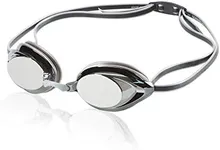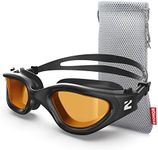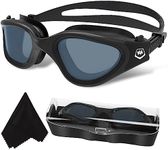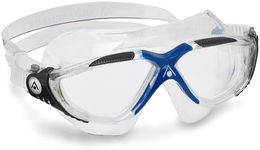Buying Guide for the Best Swimming Goggles
Choosing the right swimming goggles can make a big difference in your comfort and performance in the water. The best goggles for you will depend on where and how you swim, as well as your personal preferences for fit and visibility. It's important to consider how the goggles feel on your face, how well they keep water out, and how clearly you can see through them. Trying on different styles and understanding the key features will help you find a pair that suits your needs and makes swimming more enjoyable.Lens TypeThe lens type refers to the material and tint of the goggle lenses. This is important because it affects how well you can see underwater and how your eyes are protected from light. Clear lenses are best for indoor swimming or low-light conditions, while tinted or mirrored lenses help reduce glare and brightness for outdoor or sunny environments. Polarized lenses can cut down on surface glare, which is useful for open water swimming. To pick the right lens type, think about where you usually swim—indoors, outdoors, or both—and choose a lens that matches those lighting conditions.
Fit and SealFit and seal describe how the goggles sit on your face and how well they keep water out. This is crucial for comfort and preventing leaks. Goggles come in different shapes and sizes, with various gasket materials like silicone or foam. Some are designed for a wider fit, while others are more narrow. To find the best fit, try pressing the goggles gently onto your eyes without the strap; if they stay in place for a few seconds, they likely have a good seal. Consider your face shape and whether you prefer a soft or firm feel around your eyes.
Strap DesignThe strap design refers to how the goggles are held on your head. This is important for keeping the goggles secure during swimming. Some goggles have a single strap, while others have a split or double strap for extra stability. Adjustable straps allow you to customize the tightness. If you swim competitively or do flip turns, a more secure strap design can help keep the goggles in place. For casual or recreational swimming, comfort may be your top priority.
Anti-Fog CoatingAnti-fog coating is a special treatment on the inside of the lenses that helps prevent them from fogging up. This is important because foggy goggles can make it hard to see and disrupt your swim. Some goggles come with a built-in anti-fog layer, while others may require you to apply an anti-fog solution. If you swim for long periods or in warm pools, anti-fog features can be especially helpful. Choose goggles with a reliable anti-fog treatment if clear vision is a priority for you.
AdjustabilityAdjustability refers to how easily you can change the fit of the goggles, including the strap and sometimes the nose bridge. This is important for getting a comfortable and leak-free fit. Some goggles have interchangeable nose pieces or adjustable nose bridges to fit different face shapes. If you have trouble finding goggles that fit well, look for models with more adjustability options so you can customize them to your face.
DurabilityDurability is about how well the goggles hold up over time, especially with frequent use. This is important if you swim often or want your goggles to last. Look for goggles made from high-quality materials like silicone gaskets and shatter-resistant lenses. If you swim in chlorinated pools or saltwater, durability becomes even more important, so choose goggles that are designed to resist wear and tear.















